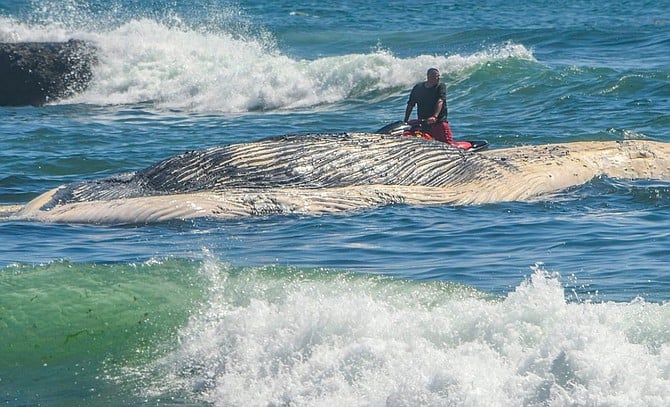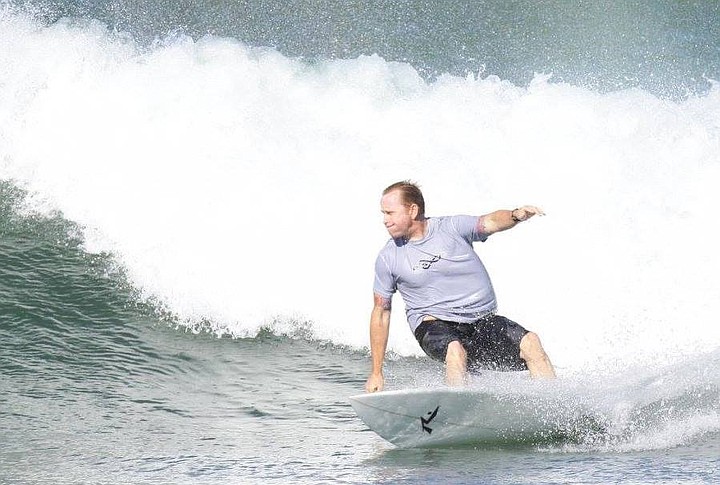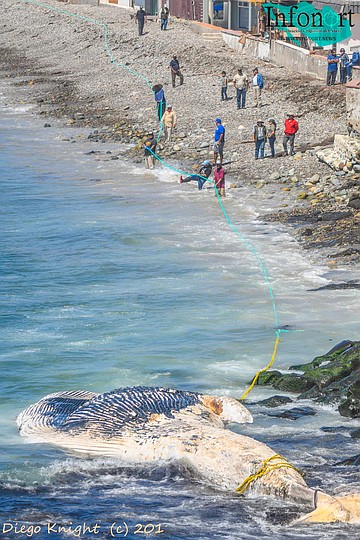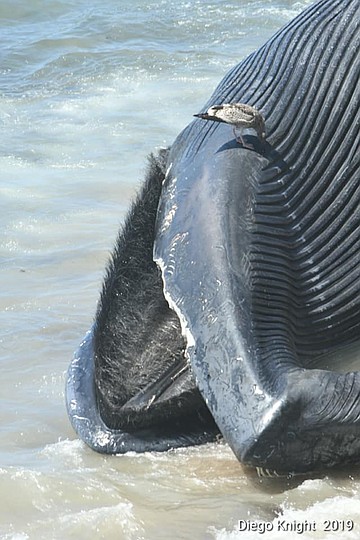 Facebook
Facebook
 X
X
 Instagram
Instagram
 TikTok
TikTok
 Youtube
Youtube

Dan M. and his fellow guests at the Club Marena rentals in Rosarito, had a rude awakening Saturday, September 7.

“Our bedroom window is positioned about 50 meters that way, and at 2 am, she (Dan’s wife) smelled something fishy,” he said on a Baja Talk Time news segment.
A whale carcass had washed up on the rocky shoreline below the rentals located south of K38 (Kilometer 38), a surf spot on Federal Highway 1 (libre) in Rosarito.
“One of the major issues that they (rescue team) have is they can’t get their equipment down to the beach since we’re pinched so close to the cliff.” Dan said. “So yesterday (Sept. 10), they put a spray on the whale. I think it was some calcium derivative which tamped down the smell for just a little, however with the rising tide, the ocean water managed to rinse that off and we’re back to our pungent situation.”

Matt Jones from Cardiff trekked down to K38 in July to shred on his ‘fish’ surfboard — he saw the recent whale carcass photos. “That area (K38) is not known for shark attacks, but a decomposing whale could change that,” he said to me. “For the surfers [out], some are possibly clueless or don’t care unless they see a shark.”
Dan surfs K38 and “totally” agrees with Jones.
“Some of the fellows are still out surfing,” Dan said, “my boy who is eight, and I will not be heading out until we can remove the carcass.”
A dead whale is a shark’s favorite food: it has really high fat content and [sharks] have keen senses of smell. Right now, if you look at the whale, you can see the juices heading out into the current.” (The cameraman pans from the surfers that are “about 200 yards out”, and back to the carcass, which is “about 50 yards” down the cliffs below Dan and the production crew.)

The report didn’t divulge a cause of death or species of the whale at K38, though there were observations and hypotheses floating below the segment's video and accompanying photos.
“Orcas have been known to eat the livers of sharks and whales using almost surgical type precision,” said one Facebooker; another responded: “looks like orcas got this yearling — they eat the tongue; that’s why nothing else is really torn apart.”
Another noticed the scrape marks on the whale’s belly. “[They] kind of look like prop (propellor) marks,” he said.
Jones, 50, has been surfing up and down the coast for 40 years; he manages and is the director of sales for a local surfboard manufacturing company.
“Years back, a whale washed up at San Onofre,” Jones recalled, “and as it decomposed it attracted a couple great whites that became “home grounders” and stayed in the area.”
On Sept. 12, the K38 carcass was towed out by “government officials and lifeguards at 1:30 pm” when surf height was registered at between 2-3 feet.
“We haven’t heard of any attacks yet,” Dan said, “[although now] its a higher risk situation.”


Dan M. and his fellow guests at the Club Marena rentals in Rosarito, had a rude awakening Saturday, September 7.

“Our bedroom window is positioned about 50 meters that way, and at 2 am, she (Dan’s wife) smelled something fishy,” he said on a Baja Talk Time news segment.
A whale carcass had washed up on the rocky shoreline below the rentals located south of K38 (Kilometer 38), a surf spot on Federal Highway 1 (libre) in Rosarito.
“One of the major issues that they (rescue team) have is they can’t get their equipment down to the beach since we’re pinched so close to the cliff.” Dan said. “So yesterday (Sept. 10), they put a spray on the whale. I think it was some calcium derivative which tamped down the smell for just a little, however with the rising tide, the ocean water managed to rinse that off and we’re back to our pungent situation.”

Matt Jones from Cardiff trekked down to K38 in July to shred on his ‘fish’ surfboard — he saw the recent whale carcass photos. “That area (K38) is not known for shark attacks, but a decomposing whale could change that,” he said to me. “For the surfers [out], some are possibly clueless or don’t care unless they see a shark.”
Dan surfs K38 and “totally” agrees with Jones.
“Some of the fellows are still out surfing,” Dan said, “my boy who is eight, and I will not be heading out until we can remove the carcass.”
A dead whale is a shark’s favorite food: it has really high fat content and [sharks] have keen senses of smell. Right now, if you look at the whale, you can see the juices heading out into the current.” (The cameraman pans from the surfers that are “about 200 yards out”, and back to the carcass, which is “about 50 yards” down the cliffs below Dan and the production crew.)

The report didn’t divulge a cause of death or species of the whale at K38, though there were observations and hypotheses floating below the segment's video and accompanying photos.
“Orcas have been known to eat the livers of sharks and whales using almost surgical type precision,” said one Facebooker; another responded: “looks like orcas got this yearling — they eat the tongue; that’s why nothing else is really torn apart.”
Another noticed the scrape marks on the whale’s belly. “[They] kind of look like prop (propellor) marks,” he said.
Jones, 50, has been surfing up and down the coast for 40 years; he manages and is the director of sales for a local surfboard manufacturing company.
“Years back, a whale washed up at San Onofre,” Jones recalled, “and as it decomposed it attracted a couple great whites that became “home grounders” and stayed in the area.”
On Sept. 12, the K38 carcass was towed out by “government officials and lifeguards at 1:30 pm” when surf height was registered at between 2-3 feet.
“We haven’t heard of any attacks yet,” Dan said, “[although now] its a higher risk situation.”
Comments